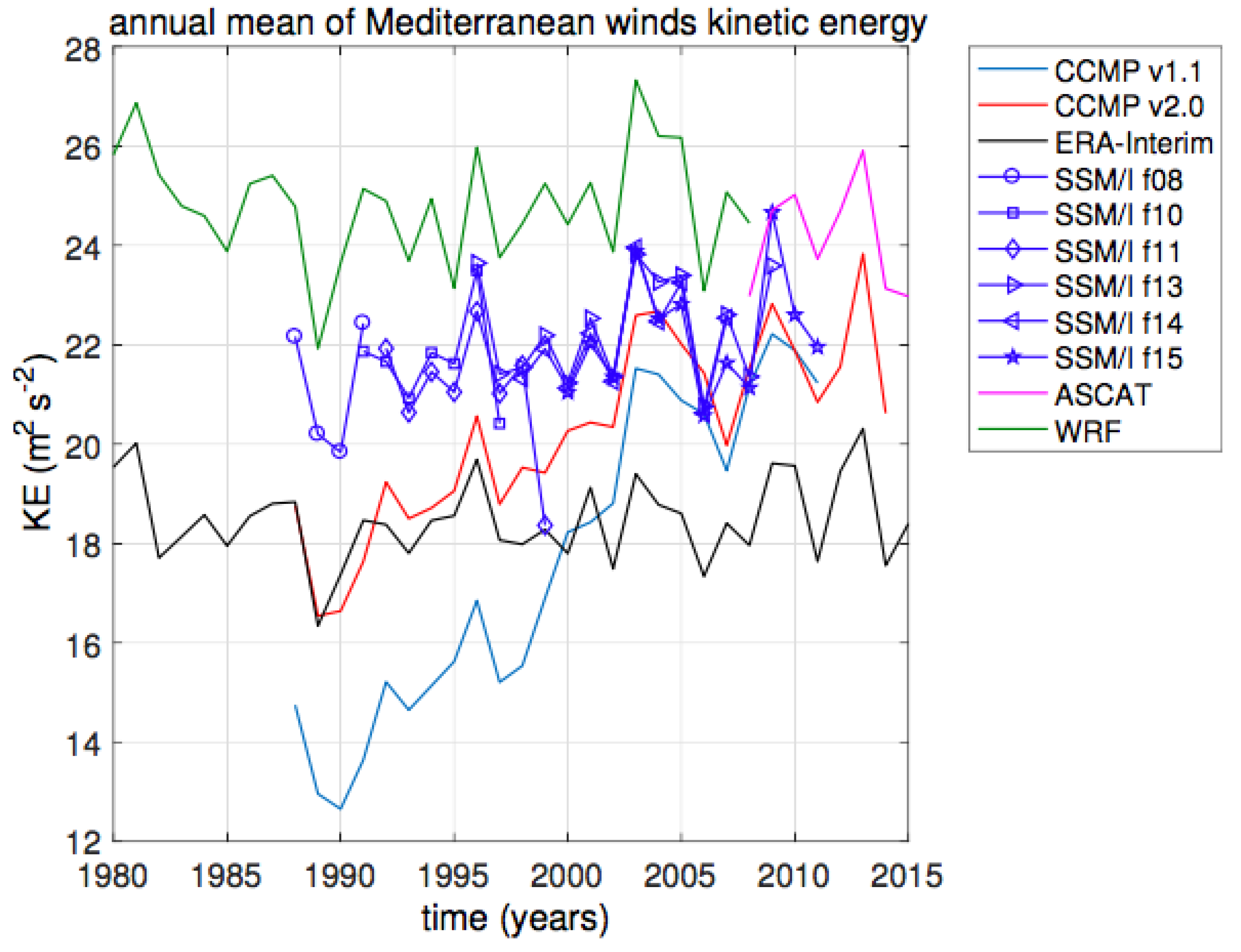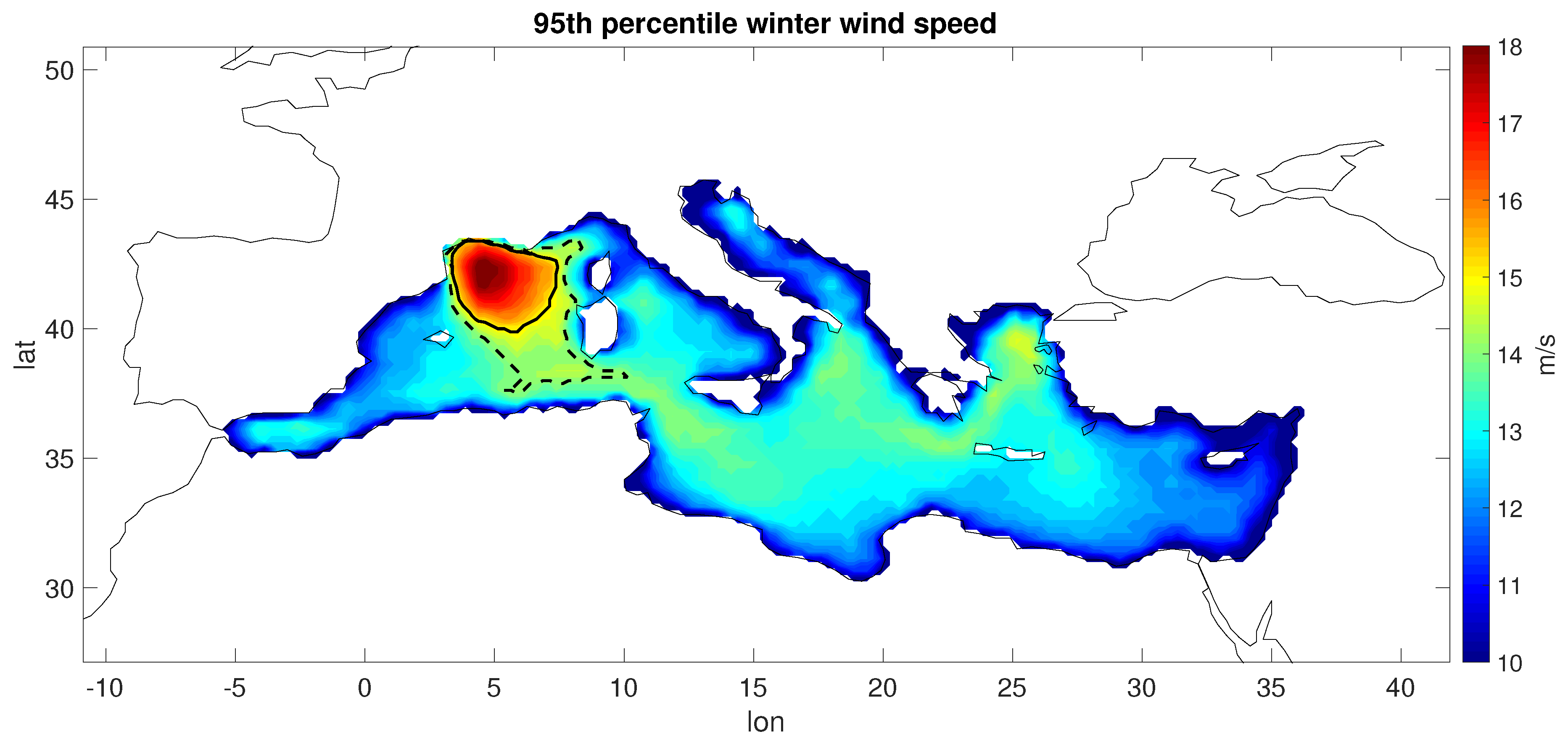Ocean Surface Anomalies after Strong Winds in the Western Mediterranean Sea
Abstract
:1. Introduction
2. Materials and Methods
2.1. Data
2.2. Methods
2.2.1. Intense Wind Events Characterization
2.2.2. Composite Analysis of Ocean Signature of Intense Wind Events
3. Results
3.1. Intense Winds Record
3.2. Composite Analysis in Winter
3.3. Composite Analysis in Summer
4. Discussion
Author Contributions
Funding
Conflicts of Interest
Appendix A. Spurious Trends in CCMP Wind Data in the Mediterranean Region

References
- Price, J.F. Upper ocean response to a hurricane. J. Phys. Oceanogr. 1981, 11, 153–175. [Google Scholar] [CrossRef]
- Mei, W.; Pasquero, C. Spatial and temporal characterization of sea surface temperature response to tropical cyclones. J. Clim. 2013, 26, 3745–3765. [Google Scholar] [CrossRef]
- Mei, W.; Pasquero, C.; Primeau, F. The effect of translation speed upon the intensity of tropical cyclones over the tropical ocean. Geophys. Res. Lett. 2012, 39, L07801. [Google Scholar] [CrossRef]
- Sanford, T.B.; Price, J.F.; Girton, J.B.; Webb, D.C. Highly resolved observations and simulations of the ocean response to a hurricane. Geophys. Res. Lett. 2007, 34, L13604. [Google Scholar] [CrossRef]
- Price, J.F.; Morzel, J.; Niiler, P.P. Warming of SST in the cool wake of a moving hurricane. J. Geophys. Res. Ocean. 2008, 113, C07010. [Google Scholar] [CrossRef]
- Boccaletti, G.; Ferrari, R.; Fox-Kemper, B. Mixed layer instabilities and restratification. J. Phys. Oceanogr. 2007, 37, 2228–2250. [Google Scholar] [CrossRef]
- Mei, W.; Pasquero, C. Restratification of the upper ocean after the passage of a tropical cyclone: A numerical study. J. Phys. Oceanogr. 2012, 42, 1377–1401. [Google Scholar] [CrossRef]
- Emanuel, K. Contribution of tropical cyclones to meridional heat transport by the oceans. J. Geophys. Res. Atmos. 2001, 106, 14771–14781. [Google Scholar] [CrossRef]
- Sriver, R.L.; Huber, M. Modeled sensitivity of upper thermocline properties to tropical cyclone winds and possible feedbacks on the Hadley circulation. Geophys. Res. Lett. 2010, 37, L08704. [Google Scholar] [CrossRef]
- Jansen, M.F.; Ferrari, R.; Mooring, T.A. Seasonal versus permanent thermocline warming by tropical cyclones. Geophys. Res. Lett. 2010, 37, L03602. [Google Scholar] [CrossRef]
- Mei, W.; Primeau, F.; McWilliams, J.C.; Pasquero, C. Sea surface height evidence for long-term warming effects of tropical cyclones on the ocean. Proc. Natl. Acad. Sci. USA 2013, 110, 15207–15210. [Google Scholar] [CrossRef] [PubMed] [Green Version]
- Emanuel, K. Genesis and maintenance of Mediterranean hurricanes. Adv. Geosci. 2005, 2, 217–220. [Google Scholar] [CrossRef]
- Cavicchia, L.; von Storch, H.; Gualdi, S. Mediterranean Tropical-Like Cyclones in Present and Future Climate. J. Clim 2014, 27, 7493–7501. [Google Scholar] [CrossRef] [Green Version]
- Ragone, F.; Mariotti, M.; Parodi, A.; Von Hardenberg, J.; Pasquero, C. A Climatological Study of Western Mediterranean Medicanes in Numerical Simulations with Explicit and Parameterized Convection. Atmosphere 2018, 9, 397. [Google Scholar] [CrossRef]
- Gonzalez-Aleman, J.J.; Pascale, S.; Gutierrez-Fernandez, J.; Murakami, H.; Gaertner, M.A.; Vecchi, G.A. Potential Increase in Hazard From Mediterranean Hurricane Activity With Global Warming. Geophys. Res. Lett. 2019, 46, 1754–1764. [Google Scholar] [CrossRef]
- MEDOC GROUP. Observation of formation of deep water in the Mediterranean sea, 1969. Nature 1970, 227, 1037–1040. [Google Scholar] [CrossRef]
- D’Ortenzio, F.; Iudicone, D.; de Boyer Montegut, C.; Testor, P.; Antoine, D.; Marullo, S.; Santoleri, R.; Madec, G. Seasonal variability of the mixed layer depth in the Mediterranean Sea as derived from in situ profiles. Geophys. Res. Lett. 2005, 32, L12605. [Google Scholar] [CrossRef]
- Houpert, L.; Testor, P.; de Madron, X.D.; Somot, S.; D’Ortenzio, F.; Estournel, C.; Lavigne, H. Seasonal cycle of the mixed layer, the seasonal thermocline and the upper-ocean heat storage in the Mediterranean Sea derived from observations. Prog. Oceanogr. 2014, 132, 333–352. [Google Scholar] [CrossRef]
- Somot, S.; Houpert, L.; Sevault, F.; Testor, P.; Bosse, A.; Taupier-Letage, I.; Bouin, M.N.; Waldman, R.; Cassou, C.; Sanchez-Gomez, E.; et al. Characterizing, modelling and un- derstanding the climate variability of the deep water formation in the North-Western Mediterranean Sea. Clim. Dyn. 2018, 51. [Google Scholar] [CrossRef]
- Schott, F.; Visbeck, M.; Send, U. Open ocean deep convection, Mediterranean and Greenland Seas. In Ocean Processes in Climate Dynamics; Malanotte-Rizzoli, P., Robinson, A., Eds.; Kluwer Acad.: Norwell, MA, USA, 1994; pp. 203–225. [Google Scholar]
- Giordani, H.; Lebeaupin-Brossier, C.; Leíge, F.; Caniaux, G. A PV-approach for dense water formation along fronts: Application to the Northwestern Mediterranean. Geophys. Res. Lett. 2017, 122, 995–1015. [Google Scholar] [CrossRef]
- Waldman, R.; Brüggeman, N.; Bosse, A.; Spall, M.; Somot, S.; Sevault, F. Overturning the Mediterranean thermohaline circulation. Geophys. Res. Lett. 2018, 45, 8407–8415. [Google Scholar] [CrossRef]
- Banzon, V.; Smith, T.M.; Chin, T.M.; Liu, C.; Hankins, W. A long-term record of blended satellite and in situ sea-surface temperature for climate monitoring, modeling and environmental studies. Earth Syst. Sci. Data 2016, 8, 165–176. [Google Scholar] [CrossRef] [Green Version]
- Atlas, R.; Hoffman, R.N.; Ardizzone, J.; Leidner, S.M.; Jusem, J.C.; Smith, D.K.; Gombos, D. A cross-calibrated, multiplatform ocean surface wind velocity product for meteorological and oceanographic applications. Bull. Am. Meteorol. Soc. 2011, 92, 157–174. [Google Scholar] [CrossRef]
- Wentz, F.; Scott, J.; Hoffman, R.; Leidner, M.; Atlas, R.; Ardizzone, J. Remote Sensing Systems Cross-Calibrated Multi-Platform (CCMP) 6-Hourly Ocean Vector Wind Analysis Product on 0.25 deg Grid, Version 2.0. 2015. Available online: http://www.remss.com/measurements/ccmp (accessed on 10 June 2019).
- Hoffman, R.N.; Leidner, S.M.; Henderson, J.M.; Atlas, R.; Ardizzone, J.V.; Bloom, S.C. A Two-Dimensional Variational Analysis Method for NSCAT Ambiguity Removal: Methodology, Sensitivity, and Tuning. J. Atmos. Ocean. Technol. 2003, 20, 585–605. [Google Scholar] [CrossRef]
- Herrmann, M.; Bouffard, J.; Beranger, K. Monitoring open-ocean deep convection from space. Geophys. Res. Lett. 2009, 36. [Google Scholar] [CrossRef] [Green Version]
- Herrmann, M.; Auger, P.A.; Ulses, C.; Estournel, C. Long-term monitoring of ocean deep convection using multisensors altimetry and ocean color satellite data. J. Geophys. Res. Ocean. 2017, 122, 1457–1475. [Google Scholar] [CrossRef]
- Amores, A.; Jordá, G.; Arsouze, T.; Le Sommer, J. Up to what extent can we characterize ocean eddies using present?day gridded altimetric products? J. Geophys. Res. Ocean. 2018, 123, 7220–7236. [Google Scholar] [CrossRef]
- Zheng, C.W.; Pan, J.; Li, C.Y. Global oceanic wind speed trends. Ocean Coast. Manag. 2016, 129, 15–24. [Google Scholar] [CrossRef]
- Sempreviva, A.M.; Schiano, M.E.; Pensieri, S.; Semedo, A.; Tome, R.; Bozzano, R.; Borghini, M.; Grasso, F.; Soerensen, L.; Teixeira, J.; et al. Observed development of the vertical structure of the marine boundary layer during the LASIE experiment in the Ligurian Sea. Ann. Geophys. 2010, 28, 17–25. [Google Scholar] [CrossRef] [Green Version]
- Pfahl, S. Characterising the relationship between weather extremes in Europe and synoptic circulation features. Nat. Hazards Earth Syst. Sci. 2014, 14, 1461–1475. [Google Scholar] [CrossRef] [Green Version]
- Houpert, L.; de Madron, X.D.; Testor, P.; Bosse, A.; D’Ortenzio, F.; Bouin, M.N.; Dausse, D.; Le Goff, H.; Kunesch, S.; Labaste, M.; et al. Observations of open-ocean deep convection in the northwestern Mediterranean Sea: Seasonal and interannual variability of mixing and deep water masses for the 2007–2013 Period. J. Geophys. Res. Ocean. 2016, 121, 8139–8171. [Google Scholar] [CrossRef]
- Reynolds, R.W.; Smith, T.M.; Liu, C.; Chelton, D.B.; Casey, K.S.; Schlax, M.G. Daily high-resolution-blended analyses for sea surface temperature. J. Clim. 2007, 20, 5473–5496. [Google Scholar] [CrossRef]
- Waldman, R.; Somot, S.; Herrmann, M.; Bosse, A.; Caniaux, G.; Estournel, C.; Houpert, L.; Prieur, L.; Sevault, F.; Testor, P. Modeling the intense 2012–2013 dense water formation event in the northwestern Mediterranean Sea: Evaluation with an ensemble simulation approach. J. Geophys. Res. Ocean. 2017, 122, 1297–1324. [Google Scholar] [CrossRef]
- Lebeaupin Brossier, C.; Drobinski, P.; Béranger, K.; Bastin, S.; Orain, F. Ocean memory effect on the dynamics of coastal heavy precipitation preceded by a mistral event in the Northwestern Mediterranean. Q. J. R. Meteorol. Soc. 2013, 139, 1583–1597. [Google Scholar] [CrossRef]
- Berthou, S.; Mailler, S.; Drobinski, P.; Arsouze, T.; Bastin, S.; Béranger, K.; Flaounas, E.; Lebeaupin Brossier, C.; Somot, S.; Stéfanon, M. Influence of submonthly air–sea coupling on heavy precipitation events in the Western Mediterranean basin. Q. J. R. Meteorol. Soc. 2016, 142, 453–471. [Google Scholar] [CrossRef]
- Pieri, A.B.; von Hardenberg, J.; Parodi, A.; Provenzale, A. Sensitivity of precipitation statistics to resolution, microphysics, and convective parameterization: A case study with the high-resolution WRF climate model over Europe. J. Hydrometeorol. 2015, 16, 1857–1872. [Google Scholar] [CrossRef]




© 2019 by the authors. Licensee MDPI, Basel, Switzerland. This article is an open access article distributed under the terms and conditions of the Creative Commons Attribution (CC BY) license (http://creativecommons.org/licenses/by/4.0/).
Share and Cite
Ragone, F.; Meli, A.; Napoli, A.; Pasquero, C. Ocean Surface Anomalies after Strong Winds in the Western Mediterranean Sea. J. Mar. Sci. Eng. 2019, 7, 182. https://doi.org/10.3390/jmse7060182
Ragone F, Meli A, Napoli A, Pasquero C. Ocean Surface Anomalies after Strong Winds in the Western Mediterranean Sea. Journal of Marine Science and Engineering. 2019; 7(6):182. https://doi.org/10.3390/jmse7060182
Chicago/Turabian StyleRagone, Francesco, Andrea Meli, Anna Napoli, and Claudia Pasquero. 2019. "Ocean Surface Anomalies after Strong Winds in the Western Mediterranean Sea" Journal of Marine Science and Engineering 7, no. 6: 182. https://doi.org/10.3390/jmse7060182
APA StyleRagone, F., Meli, A., Napoli, A., & Pasquero, C. (2019). Ocean Surface Anomalies after Strong Winds in the Western Mediterranean Sea. Journal of Marine Science and Engineering, 7(6), 182. https://doi.org/10.3390/jmse7060182




